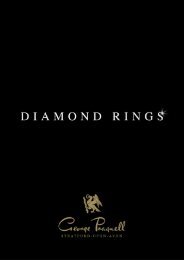Timepiece News 2013 - George Pragnell
Timepiece News 2013 - George Pragnell
Timepiece News 2013 - George Pragnell
Create successful ePaper yourself
Turn your PDF publications into a flip-book with our unique Google optimized e-Paper software.
NEW <strong>2013</strong> MODELS<br />
NEW <strong>2013</strong> MODELS<br />
IWC Celebrates it’s Legendary Portuguese Family<br />
N<br />
o other time machine<br />
approaches as close to the<br />
ideal of a perfect navigational<br />
instrument in the infinite ocean of time<br />
as a perpetual calendar from IWC. This<br />
is particularly true of the Portuguese<br />
Perpetual Calendar. The Portuguese<br />
Perpetual Calendar (Ref. 5023) with the<br />
traditional display of the moon phase<br />
is now also being manufactured in<br />
the same case size, in red gold with a<br />
silver-plated dial and in white gold with a<br />
slate-coloured dial.<br />
The Portuguese Perpetual Calendar is<br />
available with the classic cut-out moon<br />
phase display when observed from<br />
the northern hemisphere. The Earth’s<br />
satellite waxes onto this miniature stage<br />
from the left behind the semi-circular<br />
setting becomes visible in the middle<br />
as a full moon and wanes on the right<br />
side behind the second semi-circle. It<br />
is accompanied on the moon disc by<br />
small raised stars.<br />
5023<br />
The coveted Portuguese Tourbillon<br />
Mystère in two new, limited series<br />
in platinum and red gold with the<br />
retrograde date display is enhanced<br />
by an additional horological<br />
refinement, which also appears in<br />
the name of this novelty: Portuguese<br />
Tourbillon Mystère Rétrograde (Ref.<br />
5044). A date indicator with a flyback<br />
function at the end of the month has<br />
been integrated into this exceptional<br />
watch for the first time. The role of the<br />
seconds display is performed by the<br />
cage of the minute tourbillon.<br />
Since 2009, the Portuguese Minute<br />
Repeater (Ref. 5449) with the new<br />
IWC-manufactured 98950-calibre<br />
movement in hunter style has chimed<br />
out the time in the most delightful<br />
way. Since then, it has also had the<br />
small seconds at “6 o’clock”. Each of<br />
the two variants in platinum and red<br />
gold is limited to 500 watches.<br />
5449<br />
GRAND COMPLICATION<br />
Limited to a mere six pieces: The most complicated and most exclusive A. Lange & Söhne<br />
timepiece ascends to the pinnacle of precision watchmaking.<br />
T<br />
he GRAND COMPLICATION<br />
features a host of fascinating<br />
functions and yet again<br />
manifests the ability of the Saxon<br />
master watchmakers to conquer<br />
ever new peaks with their<br />
undisputed ingenuity. Beneath the<br />
lucidly configured enamel dial, the<br />
horological opus with the calibre<br />
designation L1902 incorporates<br />
scores of lavishly finished parts,<br />
bringing to life the most elaborate<br />
complications which the art of haute<br />
horlogerie has to offer: Chiming<br />
mechanism with grand and<br />
small strike, minute repeater, splitseconds<br />
chronograph with minute<br />
counter and jumping seconds as<br />
well as a perpetual calendar with<br />
moonphase display.<br />
The development of the GRAND<br />
COMPLICATION is an adventurous<br />
expedition into the cosmos of<br />
complexity. The result is a watch<br />
that is extraordinary in every respect,<br />
reflecting the brilliance of the Lange<br />
dynasty’s forebears and the virtuosity<br />
of today’s watchmakers.<br />
A sound of inimitable purity<br />
Two carefully hand-wrought gongs<br />
produce the seductive tones of the<br />
minute repeater and of the hour and<br />
quarter-hour strikes. The GRAND<br />
COMPLICATION is endowed<br />
with a chiming mechanism that<br />
automatically indicates the time in<br />
the grand strike (grande sonnerie) or<br />
small strike (petite sonnerie) modes.<br />
Every fifteen minutes, when set<br />
to grande sonnerie, it first indicates<br />
the full hour on the low-pitched gong<br />
and then the quarter-hours with a<br />
double strike on both gongs. In the<br />
petite sonnerie mode, it indicates<br />
the elapsed quarter-hours with one,<br />
two, or three double strikes on both<br />
gongs. At the top of every hour,<br />
it strikes the time in hours on the<br />
low-pitched gong.<br />
It is no coincidence that the<br />
grande sonnerie is considered to<br />
be one of the most challenging of<br />
all complications in watchmaking.<br />
It imposes extreme requirements<br />
on the perfect interaction of<br />
intricate mechanisms crafted from<br />
materials of the highest quality<br />
by exceptionally talented and<br />
experienced watchmakers. “Free,<br />
with no shake” – that is the mantra<br />
which governs the interplay between<br />
moving parts to such a degree<br />
of accuracy that they deliver a<br />
precise strike and sound with<br />
unmatched purity.<br />
The chiming mechanism is<br />
powered by one of a total of three<br />
mainspring barrels. They are wound<br />
with the crown. Turning the crown<br />
clockwise tensions the springs for<br />
the going train and the chronograph.<br />
The chiming mechanism barrel is<br />
wound in the opposite direction.<br />
When the slide in the case flank<br />
is actuated, the minute repeater<br />
indicates the time on demand with<br />
two gongs: The hours sound with<br />
low-pitched tones, the quarterhours<br />
with double-tone strikes, and<br />
the minutes with high-pitched tones.<br />
At 7:52, for instance, the melody<br />
consists of seven low tones,<br />
three double strikes, and seven<br />
high tones.<br />
9 10




